|
|
 |
 |
 |
 |
|
FIRST PERSON1930s Columbia RememberedBy Bernard R. Queneau '32
Columbia College in the 1930s had little resemblance to the Columbia of the 21st century. There was no Butler Library, 116th Street was open to traffic and the South Quadrangle was used for varsity and intramural sports. Most of the library books were dispersed throughout the campus, the gymnasium was totally inadequate for 1,600 undergraduates and there was no student union for social activities. But perhaps even more than the physical changes, advances in technology and the greater sophistication of the student body have made Columbia a very different place today. The major difference is the background and training of the student body. When I attended, more than 80 percent of the students were from the New York metropolitan area, and many remained commuters for all four years. These students were not encouraged to nor could readily participate in campus activities. We were an all-male campus, and freshmen had to take physical education where we learned, many for the first time, about the facts of life, and were advised strongly to do our dating with co-eds near the campus — Barnard and Teachers College — and to stay away from the ladies of the night in New York. On campus, freshmen had to wear beanies so sophomores could easily spot them. Each year, there were two fairly formalized competitions between the two classes. The dinners were held in large hotels, and the class with the largest attendance won. Unfortunately, somewhere in the 1920s, it became legitimate to take members of the other class “prisoner” and count them among your attendees (never mind that their hands were tied behind their backs and they didn’t eat a thing). In 1928, the Freshman Dinner was held in Newark, N.J., and some 300 young men started to eat a good meal. A gang of sophomores showed up and disrupted the banquet in their attempt to release their classmates. Open fighting erupted, and the Newark police were called. They saw that they were under-manned, so the riot police were brought in, and we learned quickly that they meant business. After a couple of heads were cracked with police nightsticks, the captain told us on a bullhorn to get back to New York. He said if we didn’t move fast, we would know the inside of a Newark jail. We moved fast! The reason for mentioning these class dinners and the resulting chaos is that the administration looked the other way and in effect said, “Boys will be boys.” However, the next year, a large group of sophomores located the Freshman Dinner in a fancy inn in Westchester County. Another melee ensued, leaving the inn in shambles. The inn sued the University for damages and received more than $50,000, which was assessed among freshmen and sophomores, some $50 each. The College then finally put a stop to such affairs. Athletics were important, and students were required to participate in a sport, either intramural or varsity. Sports probably were not as much a factor at Columbia as at other Ivy League schools because of the large group of preprofessionals and the New York City location. In 1931, the differentiation between “major” and “minor” sports was eliminated, which meant primarily that members of the cross-country, swimming, water polo, wrestling, fencing and tennis teams became members of the Varsity “C” Club and were awarded the large “C.” The arrival of Lou Little as head football coach gave the student body much to cheer about. The first major victory was a 19–6 win in 1931 against Dartmouth, a team with two All-Americans in the backfield, Bill Morton and Bill McCall. The Lions made steady progress under Little and won the Rose Bowl 7–0 against Stanford on January l, 1934. Undergraduate courses may not have been too different in the 1930s for the first two years of study. The two-year course in Contemporary Civilization, covering the fundamental subjects of history, philosophy, economics, politics and sociology, must be fairly similar. [Editor’s note: Please see related CC article on page 31.] We had extensive reading, and the classes were most interesting because they consisted not only of lectures but also intense discussions. Most of the other courses for pre-professional students were required, so only regular A.B. candidates were able to choose many electives. Columbia’s faculty had an outstanding reputation, and, for the most part, the professors combined a deep knowledge of the subject with a genuine desire to impart this subject to the lowly undergraduates. The 1930s were difficult years to graduate from the College due to the Depression. The professionals had a big advantage of several more years of medical or law school before seeking a job. Most of the other graduates had a difficult time, with few real job opportunities. As a group, we were optimistic, believed in ourselves and predicted that we’d be earning $1,000 per month within five years. Although it was more like 20 years, as a class, we enjoyed our time at Columbia, were glad we attended Columbia and wish her well in the years ahead. After earning his Met.E. in ’33 from the Engineering School, Bernard R. Queneau ’32 earned his Ph.D. at the University of Minnesota in 1936. He was called to duty in the Navy in 1941 and served for five years. Later, he worked as chief metallurgist for U.S. Steel, Duquesne Works and TCI Division, then as general manager of quality assurance at Duquesne Works. After retiring in 1977, he served as technical editor of the Iron and Steel Society’s magazine until 1983. Queneau married Henrietta Nye in 1941, and they had three daughters: Jean, Anne and Margot. Henrietta died in 1970, and in 1974, Queneau married Mary Goettge, who died in 1999. On May 31, 2003, he married Esther M. Oyster.
|
|
||||||||||||||||||||||||||||||||||||||||||||||||||||||||||
